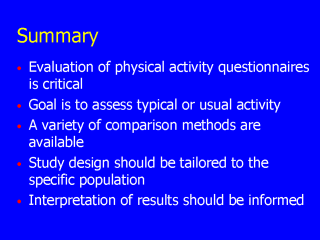| front |1 |2 |3 |4 |5 |6 |7 |8 |9 |10 |11 |12 |13 |14 |15 |16 |17 |18 |19 |20 |21 |22 |23 |24 |25 |26 |27 |28 |29 |review |
 |
-
Questionnaires have become the primary method for measuring physical activity in
epidemiologic studies. Because epidemiologic questionnaires are based upon self-reported
physical activity data, documenting the reproducibility and validity of any new
questionnaire is critical. - Because we are interested in the association between physical activity and disease, the goal is most often to assess typical or usual physical activity (energy expenditure). - Both subjective and objective comparison measures are available to validate questionnaires, each with their own strengths and weaknesses. - The study design should be based upon the time frame of the questionnaire, variation in physical activity, and consider subject burden. Ideally, comparison measures should be administered for a sufficient number of days to represent average activity.- Finally, because there is no perfect measure of typical or long-term energy expenditure, interpretation of results of validity/reproducibility studies should be informed by an understanding of the sources of error associated with both the questionnaire and the comparison method. |